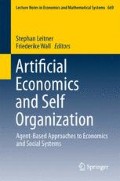Abstract
The paper uses two formal models of simple processes in artificial worlds—one with and one without an analytical solution—to discuss the role of statistical analysis and significance tests of results from multiple simulation runs. Moreover the paper argues that it is not the sheer existence of an effect of input parameters on simulation results but the effect size which is the interesting outcome of a simulation and that significance tests of differences in means are much less important than the distribution of output variables which are more often than not non-normal distributions.
Access this chapter
Tax calculation will be finalised at checkout
Purchases are for personal use only
Notes
- 1.
For an in-depth discussion of “the cult of statistical significance” see [8]. Particularly, Ziliak and McCloskey criticise the use of sentences like “The differences reached the level of statistical significance, by and large.” [p. 35]. Their general argument is that it is not enough to “decide ‘whether there exists an effect’ ” [p. 25], but that it is necessary to ask “the scientific question ‘How much is the effect?’ ”.
- 2.
A numerical solution of this system of differential equations is a simulation of the macro object ‘population’ with the vector-valued attribute ‘probability of being in one of the possible states’.
- 3.
This model goes back to discussions between Gregor van der Beek, two master students and the author, was partly documented in the two students’ master thesis [5] and extended by the present author.
- 4.
The current version of the model can be found among the NetLogo User Community Models, http://ccl.northwestern.edu/netlogo/models/community/MinimumWages.
References
Alker HR Jr (1974) Computer simulations: inelegant mathematics and worse social science? Int J Math Educ Sci Technol 5:139–155
Balzer W, Moulines CU, Sneed JD (1987) An architectonic for science. The structuralist program. Volume 186 of synthese library. Reidel, Dordrecht
Epstein JM, Axtell R (1996) Growing artificial societies – social science from the bottom up. MIT, Cambridge MA
Ihrig M, Troitzsch KG (2013) An extended research framework for the simulation era. In: Diaz R, Longo F (eds) 2013 Spring simulation multiconference on emerging M&S applications in industry and academia symposium and the modeling and humanities (EAIA and MathH 2013) (SpringSim ’13). Simulation Series, vol 45(5). Curran Associates, Red Hook, pp 99–106
Jazayeri P, Tohum MH (2012) Auswirkung der Einführung eines Mindestlohns auf den Arbeitsmarkt, anhand eines Simulationsmodells. http://kola.opus.hbz-nrw.de/volltexte/2012/759/
Ostrom T (1988) Computer simulation: the third symbol system. J Exp Soc Psychol 24:381–392
Weidlich W, Haag G (1983) Concepts and models of a quantitative sociology. The dynamics of interacting populations. Springer series in synergetics, vol 14. Springer, Berlin
Ziliak ST, McCloskey DN (2007) The cult of statistical significance. The University of Michigan Press, Ann Arbor
Author information
Authors and Affiliations
Corresponding author
Editor information
Editors and Affiliations
Rights and permissions
Copyright information
© 2014 Springer International Publishing Switzerland
About this chapter
Cite this chapter
Troitzsch, K.G. (2014). Simulation Experiments and Significance Tests. In: Leitner, S., Wall, F. (eds) Artificial Economics and Self Organization. Lecture Notes in Economics and Mathematical Systems, vol 669. Springer, Cham. https://doi.org/10.1007/978-3-319-00912-4_2
Download citation
DOI: https://doi.org/10.1007/978-3-319-00912-4_2
Published:
Publisher Name: Springer, Cham
Print ISBN: 978-3-319-00911-7
Online ISBN: 978-3-319-00912-4
eBook Packages: Business and EconomicsEconomics and Finance (R0)

